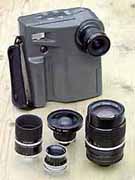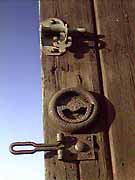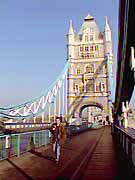EPIXPRO DIGITAL CAMERA
a whole new approach to using digital images
by John Henshall

EPixPro camera with 6mm wideangle lens fitted. In the foreground, from left to right, 50mm f1.4 Switar, 16mm f1.8 Switar (both from a 1950s Bolex H16 cine camera), 4mm f1.4 Tarcus fisheye for CCTV cameras and 105mm f2.5 Nikkor on 'C' mount adaptor.



Images captured with the prototype EPixPro camera at 640x480
pixels. Reproduced here at 180x135 pixels.
There is now a wide choice of digital cameras, with more appearing every
month. The technique seems to be to lob a new camera over the wall into
the market place and see who picks it up and finds an application for it.
After a while, working with digital cameras seems routine. You install the
Adobe Photoshop plug-in or special stand-alone software and communicate
with the camera, either by SCSI or serial cable. Some cameras force you
to acquire one image at a time, saving it in your chosen file format with
your own filename. Others acquire the images slowly over a serial cable,
interpolating them on the way. It is slow, labour intensive and - consequently
- expensive. You get used to nodding-off in front of the computer as you
wait.
Business communicators have taken the developments in desktop publishing
on-board in a big way over the past decade. They are used to a wide variety
of scalable fonts and are now turning their attention to using colour -
and images. But they are not interested in plug-ins, file formats, colour
temperature, CMYK conversions and the like. They just want their images,
in the right place, without any fuss. And they want them on demand.
John P Moon was a VP at Apple Computer for thirteen years. His department
was responsible for the original LaserWriter 1 through to the Quicktake
camera. After leaving Apple he set up EPix Imaging Systems to combine hardware
and software into a seamless system of image workflow management, from capture
through to output. An impressive list of employees includes a former camera
designer from Leaf Systems and a colour scientist from Electronics For Imaging.
EPix Imaging Systems' target customers already have a workflow - they have
PC, word processor and database. EPix's objective is to enable them to integrate
images into their existing systems. Looking around, it struck them that
there was no suitable digital camera, so they set out to design their own
- the EPixPro - from the ground up, with all the right attributes to allow
images to move quickly into the customers' system and to match his output
requirements - there is no point in having image files which are so big
that each one must be sampled down in size.
To keep costs down, EPix use off-the-shelf components as far as possible.
A standard half-inch Sony CCD gives a 640 by 480 pixel 13 inch 'screenful'
of image. The camera has a through the lens viewfinder and takes interchangeable
lenses - unheard of on other low-res digital cameras. The type 'C' lens
mount is standard for 16mm cine cameras and CCTV cameras. This ensures that
a wide variety of lenses is readily available - including macro, fisheye,
ultra-wide angles, zooms, night vision and microscope adaptors. Even Canon,
Minolta and Nikon 35mm lenses may be used with a 'C' mount adaptor.
The viewfinder image is uninterrupted by the shutter, which - as in most
television cameras - is purely electronic. Since the CCD is always sensing
the light entering the lens, no exposure meter is necessary. The camera
itself becomes the exposure meter, measuring only the light which forms
the image. Correct exposure is as easy as ensuring that the green '+' and
'-' symbols in the viewfinder are both lit. In practice, the range of automatic
electronic shutter speeds is so wide that, in normal light, the shutter
can cope. In these conditions, the aperture setting makes little difference
to exposure. Photographers might find this a little unsettling but this
is not a camera for photographers - it is a camera for users of images.
The highly intelligent built-in-flash exposure system first fires a 'ball
park' flash before a second is used to calculate the exposure precisely.
The third and fourth flashes make the exposure. The only thing lacking is
a flash sync socket for triggering off-camera flash.
The camera is made to EPix design by NEC in Japan. This is the kind of alliance
we are seeing more of, such as that between Kodak and Chinon for DC40 and
DC50 cameras. NEC will market the EPixPro in Japan and the far east.
A standard camcorder-type lithium ion battery powers both camera and on-board
486 computer. This kind of battery is a new industry standard which can
be bought economically in a local camera shop. It's a much better idea than
using a battery designed specifically for the camera. These tend to be expensive
and difficult to source in an emergency.
The EPixPro has two internal PCMCIA slots and can store 1600 images on a
standard 131MB type 3 drive. The images are stored in standard JPEG format
and can be opened directly in programs such as Word, Wordperfect, QuarkXPress,
Netscape Navigator - and Photoshop - without needing special plug-ins or
other software. Indeed, this is the first camera I have seen which does
not need any of its own software to view the images. Software is important
to the EPix system but it is integrated into workflow management, rather
than being a series of stand-alone utilities.
In fact, the EPixPro is more like a computer with a lens on the corner,
for it has an on-board 486 processor. The user can upload his own parameters
to this, for example special image sizes and compression for identity passes,
which tell the camera how to process the image immediately after it has
been captured. Account setup in the camera also enables images can be assigned
to user-selectable accounts at the time of exposure. Back at base, the images
are read off the PCMCIA card and moved directly to their correct locations
in the database. No manual work is involved - this is real productivity.
The price of the EPixPro is expected to be around £1800 ($1950 in the
USA). Applications include the capture and automatic placement of images
for identity cards, insurance claims, estate agents and other vertical markets.

I have had a prototype EPixPro camera for a couple of months, evaluating
it and other EPix plans for an independent 'due diligence' report for a
north American securities commission. Pre-production consultancy such as
this is a major part of my work - work which is, of course, highly confidential.
I can however tell you that EPix Imaging Systems have some fascinating ideas
up their sleeves for the future. In the meantime, the EPixPro is a welcome
move towards integrated workflow management. It could soon make other cameras
in its resolution class look like amateurs hankering after a bit of semi-professional
work on the side.
EPix have appointed Bannerbridge plc (01268 419101) as
their sole UK agents. They will also be working closely with NBA Quality
Systems Ltd (01483 301970) for special application developments.
This review first appeared as "John Henshall's Chip Shop" in "The Photographer" magazine, March 1996.
IMPORTANT NOTICE
This document is Copyright © 1996 John Henshall. All rights reserved.
This material may only be downloaded for personal non-commercial use. Please
safeguard the future of online publishing by respecting this copyright and
the rights of all other authors of material on the Internet.






